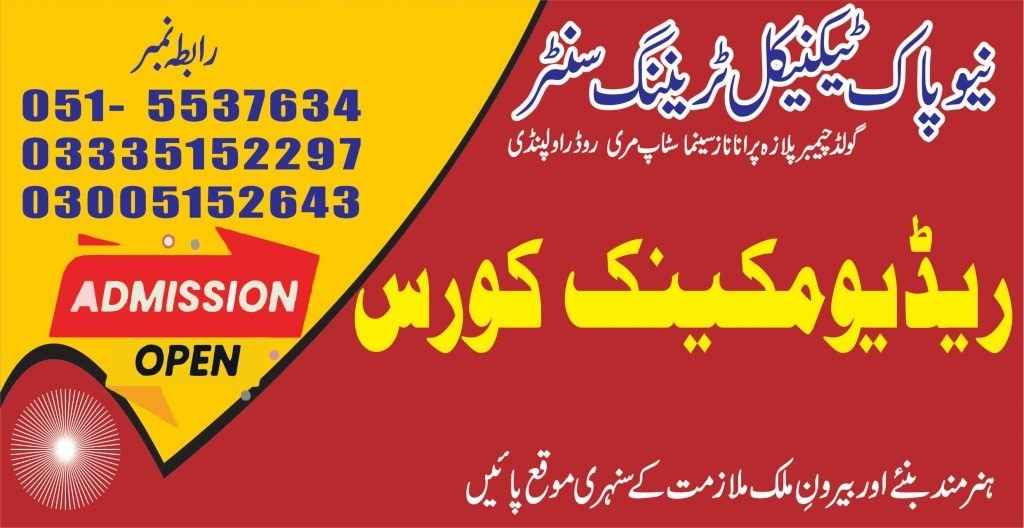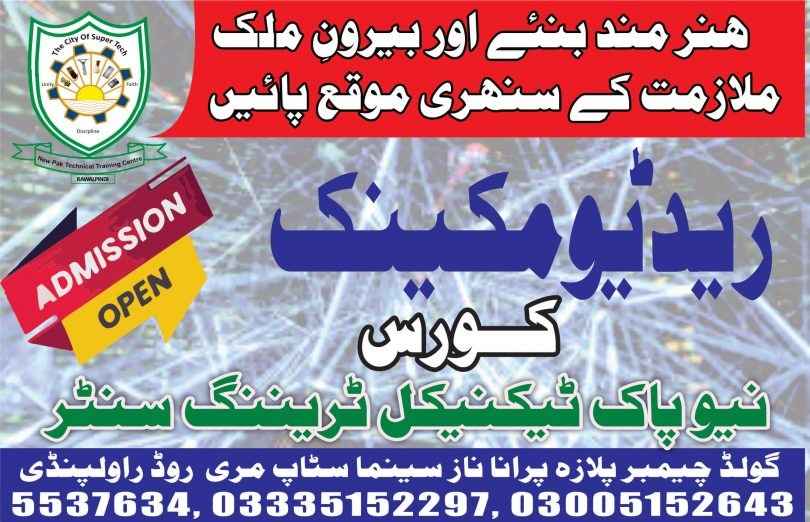
Radio Mechanic Course In Rawalpindi Islamabad
The Radio Mechanic Course is designed to provide practical and theoretical training in radio communication systems and electronics. Whether you’re aiming to work in electronics repair or as a BSF radio operator & radio mechanic, this course builds a strong foundation in troubleshooting and maintaining various radio devices. It is ideal for those pursuing a certificate in radio mechanic course to start a technical career.
Course Overview
This hands-on radio mechanic certificate program covers everything from basic circuitry and soldering to advanced RF systems, digital electronics, and diagnostic tools. Students will learn to repair, maintain, and build communication systems, preparing them for entry-level roles or advanced certifications in the field of radio mechanic work.

Course Duration
06 | Months
- Workshop Safety & Electrical Fundamentals
- Basic Electronic Components
- Radio Wave Theory & Modulation Basics
- Analog Circuit Fundamentals & Diagrams
- Soldering, Desoldering & Diagnostic Tools
- Radio Equipment Repair & Maintenance
- Audio Signal Circuits & Practical Repairs
- Practical Workshop & Final Assessment
01 | Year
- Workshop Safety & Electrical Fundamentals
- Basic Electronic Components
- Radio Wave Theory & Modulation Basics
- Analog Circuit Fundamentals & Diagrams
- Soldering, Desoldering & Diagnostic Tools
- Radio Equipment Repair & Maintenance
- Audio Signal Circuits & Practical Repairs
- Practical Workshop & Final Assessment
- Advanced Analog & Digital Radio Circuits
- Radio Frequency (RF) Systems & Amplification
- Advanced Modulation & Transmission Systems
- Digital Electronics & Microprocessors
- Advanced Troubleshooting & Diagnostic Tools
- Specialized Radio Equipment & Industry Standards
- Capstone Project & Certification
Course Outline (6 Months)
Basic Radio Theory & Circuitry
Month 1
- Workshop safety procedures and electrical safety standards
- Use of Personal Protective Equipment (PPE)
- Introduction to electrical principles: voltage, current, resistance
- Safe handling of radio equipment and tools
- Basic electronic components: resistors, capacitors, inductors
Front Office Operations
Month 2
- Fundamentals of radio waves and propagation
- AM and FM modulation basics
- Introduction to analog circuits
- Reading and interpreting simple circuit diagrams
Electronics & Diagnostic Tools
Month 3
- Soldering and desoldering techniques
- Component identification and function
- Using a multimeter for basic fault diagnosis
- Troubleshooting basic circuit faults
Radio Equipment Repair & Maintenance
Month 4
- Repair techniques for common radio equipment (car radios, walkie-talkies)
- Routine maintenance of radio devices
- Continuity testing of fuses, wires, and connections
- Speaker and headphone jack checks
Audio Circuits & Signal Basics
Month 5
- Introduction to audio signal circuits
- Basic signal testing: microphones, volume controls, potentiometers
- Cleaning and maintaining volume controls and switches
- Hands-on practical repair exercises
Practical Workshop & Assessment
Month 6
- Hands-on repair of basic radio systems
- Troubleshooting practical faults in radio equipment
- Final theoretical and practical evaluations
- Issuance of course completion certification for the 6-month program
Course Outline (1-Year)
Months 1–6: Basic Radio Mechanic Course In Rawalpindi Islamabad
(Same course content as the 6-month program but with more detail, role-plays, software demos, and assessments.)
Circuitry & Radio Frequency (RF) Systems
Month 7
- Analog and digital circuits in radio systems
- Intermediate Frequency (IF) circuits
- RF signal amplification and oscillators
Advanced Radio Systems & Modulation
Month 8
- Detailed study of modulation types beyond AM/FM
- Transmission systems and protocols
- Antenna design and configuration
Digital Electronics & Microprocessors
Month 9
- Basic digital electronics concepts
- Logic gates and binary systems
- Introduction to microprocessors in radio communication
Troubleshooting & Diagnostic Tools
Month 10
- Use of oscilloscopes and signal generators
- Diagnosing complex faults in radio systems
- Software tools for radio diagnostics
Specialized Radio Equipment
Month 11
- Aviation, marine, military, and ham radio equipment
- Installation and maintenance of specialized radios
- Industry standards and licensing regulations (FCC)
Capstone Project & Final Assessment
Month 12
- Design and build an advanced radio communication system
- Presentation and demonstration of the project to the faculty
- Final theoretical and practical evaluations
- Issuance of course completion certification for a 1-year program

Career Opportunities
- Radio Technician
- Broadcast Engineer
- Telecommunications Specialist
- Radio Frequency (RF) Engineer
- Ham Radio Operator
- Military Radio Operator
- Aviation Radio Technician
Conclusion
A radio mechanic coursein Rawalpindi Islamabad provides hands-on training in radio communication systems, including installation, maintenance, and fault diagnosis. Students gain practical skills to work with analog and digital technologies used across industries such as broadcasting, telecommunications, aviation, and defense. Completing a certificate in radio mechanics prepares individuals for roles like radio mechanic, BSF radio operator, radio mechanic, and communication technician. As digital broadcasting evolves, those holding a radio mechanic certificate and strong technical skills remain in demand in this dynamic field.






